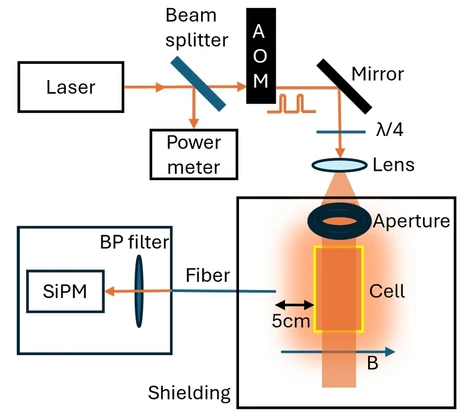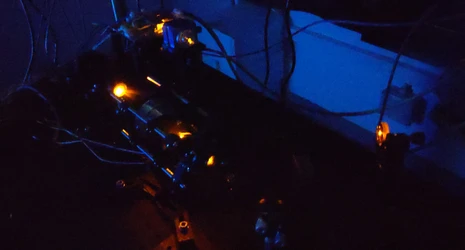Sodium Magnetometry
Overview
The sodium magnetometry project focuses on developing and characterizing optical magnetometers based on sodium vapor fluorescence.
These magnetometers are designed to be compatible with both laboratory-scale precision experiments and potential remote sensing applications in the Earth’s mesosphere, where natural sodium atoms can be optically excited and probed.
In contrast to conventional alkali-based systems such as cesium or rubidium, sodium offers unique advantages in terms of spectral accessibility, linewidth, and atmospheric relevance.
Scientific Motivation
Sodium magnetometry combines two complementary research directions at our chair:
- Laboratory-based optical magnetometry for ultra-sensitive field measurements and calibration.
- Remote magnetometry concepts, where sodium atoms in the upper atmosphere are excited by laser light and used as a natural, distributed magnetic field sensor.
These techniques could provide spatially resolved measurements of geomagnetic field variations and support atmospheric and astrophysical studies.
In parallel, laboratory sodium magnetometers serve as a testbed for spin dynamics, light–atom interaction, and resonance-based field sensing — essential knowledge for precision experiments and sensor development.
Experimental Setup and Methods
The current sodium magnetometer setup includes:
- a dedicated sodium vapor cell with temperature stabilization and optical access;
- a resonant excitation laser tuned near the D₂ line of sodium (589 nm);
- optical pumping and fluorescence detection schemes for spin polarization and readout;
- digital signal acquisition for lock-in detection of resonance features;
- a shielded magnetic field environment allowing precise control and calibration.
Initial laboratory experiments focused on optimizing fluorescence collection and quantifying magneto-optical resonance signals under controlled conditions.
These studies demonstrated magnetic resonance features consistent with optical pumping effects, paving the way for quantitative sensitivity analysis and mesospheric application modeling.
Results and Outlook
Recent results show measurable magnetic resonance signals in sodium vapor, validating the theoretical expectations and demonstrating the feasibility of sodium-based fluorescence magnetometry.
The next development steps include:
- implementing frequency modulation and phase-sensitive detection,
- quantitative calibration of magnetic sensitivity and linewidth,
- simulation and modeling of remote mesospheric signal strengths,
- comparison with cesium- and rubidium-based OPMs to benchmark performance and stability.
Ultimately, the sodium magnetometry platform will serve as both a laboratory test environment and a pathfinder for remote magnetometry, supporting atmospheric research and precision measurement applications.
Contact / Links
For collaboration, thesis opportunities, or further inquiries, please contact:
Dr. rer. nat. Florian Kuchler
- Tel.: +49 (89) 289 - 51321, 53712
- Raum: 5117.02.402
- florian.kuchler@tum.de
Publications and finished Theses
- Johannes Kowalewicz, A Lab-based Experimental Setup towards Sodium Fluorescence Magnetometry in the Mesosphere. 2025. Master´s Thesis
Involved Persons and Former Members
Currently Involved persons: Johannes Kowalewicz
Former Members:

